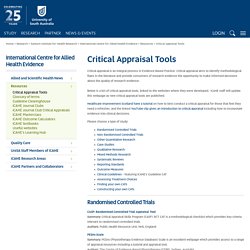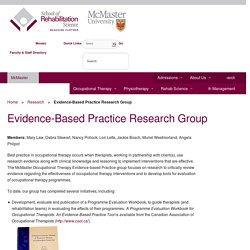

Critical appraisal checklists - Specialist Unit for Review Evidence. Critical Appraisal Tools. Critical appraisal is an integral process in Evidence Based Practice.

Critical appraisal aims to identify methodological flaws in the literature and provide consumers of research evidence the opportunity to make informed decisions about the quality of research evidence. Below is a list of critical appraisal tools, linked to the websites where they were developed. iCAHE staff will update this webpage as new critical appraisal tools are published. Healthcare Improvement Scotland have a tutorial on how to best conduct a critical appraisal for those that feel they need a refresher, and the linked YouTube clip gives an introduction to critical appraisal including how to incorpotate evidence into clinical decisions. Please choose a type of study: Randomised Controlled Trials Validation of the PEDro tool: Maher, C.
Link to Maher et al. 2003 article (pdf 301KB) top Non-Randomised Controlled Trials Other Quantitative Research Case studies Qualitative research Mixed Methods research Systematic Reviews. Critical Appraisal tools - CEBM. Centre for Evidence Based Physiotherapy. Evidence-Based Practice Research Group. Members: Mary Law, Debra Stewart, Nancy Pollock, Lori Letts, Jackie Bosch, Muriel Westmorland, Angela Philpot Best practice in occupational therapy occurs when therapists, working in partnership with client(s), use research evidence along with clinical knowledge and reasoning to implement interventions that are effective.

The McMaster Occupational Therapy Evidence-based Practice group focuses on research to critically review evidence regarding the effectiveness of occupational therapy interventions and to develop tools for evaluation of occupational therapy programmes. To date, our group has completed several initiatives, including: Development, evaluate and publication of a Programme Evaluation Workbook, to guide therapists (and rehabilitation teams) in evaluating the effects of their programmes. The COSMIN checklist. PEDro scale (English) PEDro. The PEDro scale was last amended on 21 June 1999.

This briefly explains why each item has been included in the PEDro scale. More detail on each item is provided in the PEDro scale training program. 1. eligibility criteria were specified Note on administration: This criterion is satisfied if the report describes the source of subjects and a list of criteria used to determine who was eligible to participate in the study. Explanation: This criterion influences external validity, but not the internal or statistical validity of the trial. 2. subjects were randomly allocated to groups (in a crossover study, subjects were randomly allocated an order in which treatments were received) Note on administration: A study is considered to have used random allocation if the report states that allocation was random. Explanation: Random allocation ensures that (within the constraints provided by chance) treatment and control groups are comparable. 3. allocation was concealed For all criteria.
PEDro-scale-partitioned-guidelines-jul2013.pdf. Ottawa Hospital Research Institute. GA Wells, B Shea, D O'Connell, J Peterson, V Welch, M Losos, P Tugwell, Nonrandomised studies, including case-control and cohort studies, can be challenging to implement and conduct.

Assessment of the quality of such studies is essential for a proper understanding of nonrandomised studies. The Newcastle-Ottawa Scale (NOS) is an ongoing collaboration between the Universities of Newcastle, Australia and Ottawa, Canada. It was developed to assess the quality of nonrandomised studies with its design, content and ease of use directed to the task of incorporating the quality assessments in the interpretation of meta-analytic results. A 'star system' has been developed in which a study is judged on three broad perspectives: the selection of the study groups; the comparability of the groups; and the ascertainment of either the exposure or outcome of interest for case-control or cohort studies respectively.
PRISMA. The PRISMA Statement The aim of the PRISMA Statement is to help authors report a wide array of systematic reviews to assess the benefits and harms of a health care intervention.

PRISMA focuses on ways in which authors can ensure the transparent and complete reporting of systematic reviews and meta-analyses. We have adopted the definitions of systematic review and meta-analysis used by the Cochrane Collaboration [9]. A systematic review is a review of a clearly formulated question that uses systematic and explicit methods to identify, select, and critically appraise relevant research, and to collect and analyze data from the studies that are included in the review. STROBE Statement: Home.